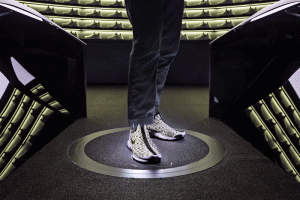Augmented reality is not a new term. In short, it encompasses any kind of computer-generated imagery that’s mixed with the live view of the real world. As a concept, it is wildly powerful and promising. While we’re far from adopting it as a common and everyday technology, AR already has much to offer. It has been mostly used through smartphone devices, but augmented reality and digital signage are becoming a more common mix by the day.
Before we dig deeper, if you’re considering investing and combining AR with digital signage, it’s important to grasp the future of this growing technology. We must first examine the current state of augmented reality, and how it can transition to mainstream adoption. With that in mind, we’ll consider what AR can do today in conjunction with digital signage and where it’s headed in the future.
The current state of augmented reality
VR and AR technologies have received massive funding in recent years and have become more accessible than ever. Recent predictions indicate that AR will become a $152 billion industry within the next ten years! Quite an exciting prospect! Even if AR doesn’t reach that milestone, it’s safe to say that by 2030, most of us will have experienced it a few times.
Undoubtedly, the biggest introduction to augmented reality was brought on by Pokémon Go in 2016. The trend has faded since then, but the world became more familiar with AR than ever. Its most popular feature relied on the entertainment factor.
Today, the spotlight is on Facebook and Apple, as they compete to own the augmented reality universe. Given their reach into the digital world, it makes sense why it’s these two who would fight for AR. But we are yet to receive a solid AR development to be launched into mainstream. The world is at the moment holding its breath!
The transition will take a long time
Did you know that a certain extent of augmented reality was first achieved in 1957? It has come a long way since then, but it still has a long way to go. At this time, there is much development needing to be done in terms of hardware, platforms, and especially content to make it as usable and accessible as it can be. The transition hasn’t even properly started yet. All we are getting is glimpses into the potential of AR. It’s fun to try out, but it’s not yet instinctive for us to use. Still, that alone holds a lot of merit, since these glimpses offer a lot of potential. Just imagine how impactful AR will be as it develops further.
Another big matter is that the world is not yet hungry for it. Simply put, the everyday user in this day and age isn’t all too interested in augmented reality. Is it exciting to try out? Is it cool and appealing? Of course! But it won’t become a key smartphone feature, that’s for sure. And let’s not even talk about AR replacing smartphones altogether! So there is no big hype to jump on the AR train, at least not yet. Once it matures in sophistication and advances to the point where it rivals current everyday technologies, the wider audience will be more open to it. Only then will it become a must-have key business ingredient the way social media, smartphone technology, or digital signage is today.
What will we see in 2022?
We can gauge how open the world will be to AR in the future by observing the frontrunners of this technology and anticipating the social and technological impact they’ll make in the year ahead.
As we mentioned, Facebook and Apple are the biggest names working on AR development. And while we hear plenty of news and speculations on both, it is uncertain what to expect in the near future. Remember what happened to Google Glass? Yeah, so let’s not jump to conclusions.
What we know thus far, Facebook’s efforts have mostly been out in the open, experimenting with software and hardware in plain sight. Furthermore, in October the Facebook company changed its name to Meta in an attempt to unite all apps and technologies under one new company brand. This “metaverse” is a clear step forward toward more immersive virtual experiences: the perfect environment for augmented reality. For what it seems, Facebook is preparing to make a splash.
Meanwhile, Apple keeps such experimentation mostly under wraps with only speculation looming on the horizon. Their Apple Glasses remain much of a mystery. Rumors, speculations, and leaks on the price, features, and release date are still the main sources of information. It is rumored to be coming out in 2023 at the earliest. So it’s likely we’ll hear more about it in 2022, and with it more on AR.
What can AR bring to digital signage?
Now that we have a glimpse into where augmented reality is in terms of development and public perception, we can consider how well it fits into your toolbox as a digital signage user.
At this time, with its features, augmented reality has much to offer when combined with digital signage. Let’s explore the journey into AR through digital signage. It begins in many ways. Most commonly, users rely on their own smartphones for AR. Using a QR code, the digital signage can direct the user to download the corresponding app. The digital display guides the user through a series of exciting interactions in augmented reality. At this stage, promotions, discounts, offers, links, and any other form of engagement can be deployed to the consumer in conjunction with the digital signage they see.
A different path, augmented reality can come from devices within the store. Shoppers use virtual mirrors to try out clothing via augmented reality, for example. A store may provide AR-ready tablets so customers can jump into augmented reality in seconds. AR can enhance all the regular ways digital signage enhances the customer experience: wayfinding, accessing product information, and of course entertainment.
Should you combine digital signage and augmented reality?
While augmented reality is by no means a leading form of advertisement, it can still be a valuable asset for your business. At its current stage of development, you can use it to enhance existing campaigns, impress the consumer, and merge AR with digital signage.
Augmented reality and digital signage will be a very powerful mix for any business in the future, but that is unlikely to happen tomorrow. So the only business that should properly use it is one that has an AR receptive audience.
AR is a relatively inexpensive effort as there is software available to deploy it. The tools are there, you just need to use them. The challenge is to make AR accessible and understandable to the user. Take time to build a campaign that clearly communicates what the user needs to do, how to download the app, and how to interact with your digital signage via augmented reality. AR-ready tablets, virtual mirrors, or other ready-to-use equipment are surely the fastest way to engage a consumer new to AR.
As you play around with simpler forms of AR, you will quickly see how receptive your audience is to it. If you notice that your audience barely responds to it or has no interest, change your approach. In the end, it may be possible your particular audience simply isn’t ready for AR, yet. Meanwhile, as you adapt and find the audience indeed is receptive to AR, only then should you consider going big and investing into high-tier augmented reality, such as these examples.









